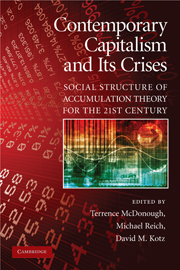Book contents
- Frontmatter
- Contents
- List of Tables
- List of Figures
- List of Contributors
- Acknowledgments
- Introduction: Social Structure of Accumulation Theory for the 21st Century
- PART I THE THEORY OF SOCIAL STRUCTURES OF ACCUMULATION
- PART II GLOBALIZATION AND THE CONTEMPORARY SOCIAL STRUCTURE OF ACCUMULATION
- PART III THE CONTEMPORARY SOCIAL STRUCTURE OF ACCUMULATION IN THE UNITED STATES
- 8 Labor in the Contemporary Social Structure of Accumulation
- 9 The Rise of CEO Pay and the Contemporary Social Structure of Accumulation in the United States
- 10 Social Structures of Accumulation and the Criminal Justice System
- PART IV SOCIAL STRUCTURE OF ACCUMULATION THEORY AND TRANSFORMATIONS OF THE CAPITALIST PERIPHERY
- Index
- References
8 - Labor in the Contemporary Social Structure of Accumulation
Published online by Cambridge University Press: 05 June 2012
- Frontmatter
- Contents
- List of Tables
- List of Figures
- List of Contributors
- Acknowledgments
- Introduction: Social Structure of Accumulation Theory for the 21st Century
- PART I THE THEORY OF SOCIAL STRUCTURES OF ACCUMULATION
- PART II GLOBALIZATION AND THE CONTEMPORARY SOCIAL STRUCTURE OF ACCUMULATION
- PART III THE CONTEMPORARY SOCIAL STRUCTURE OF ACCUMULATION IN THE UNITED STATES
- 8 Labor in the Contemporary Social Structure of Accumulation
- 9 The Rise of CEO Pay and the Contemporary Social Structure of Accumulation in the United States
- 10 Social Structures of Accumulation and the Criminal Justice System
- PART IV SOCIAL STRUCTURE OF ACCUMULATION THEORY AND TRANSFORMATIONS OF THE CAPITALIST PERIPHERY
- Index
- References
Summary
After the end of World War II, an institutional framework – the postwar social structure of accumulation (SSA) – gradually evolved, setting the stage for renewed prosperity in the United States. Domestically, this structure included two important elements. First, the federal government played a more important role in stabilizing and fostering the growth of the economy and in protecting, to a degree, individuals and businesses from competitive forces in the economy. Second, while labor and management continued to be in competitive conflict, there was a shared set of understandings about the nature of the conflict with “management's rights” and “labor's role” becoming more clearly defined. Internationally, the postwar institutional framework was characterized by the economic and political dominance of the United States.
Strains in this postwar SSA began to appear in the late 1960s and continued in the 1970s. Stagflation, one of the outward manifestations of such strains, reflected the economic and political stalemate over which groups in the United States would bear the burden for the relative decline in the economic and political hegemony of the United States. The stagflation was broken in the early 1980s, and a “neoliberal” SSA was created. While not explicitly discussed in these terms, the Reagan administration attempted to create a new institutional framework, a new SSA, for economic prosperity based on neoliberalism, or deregulated capitalism. Ideologically, the federal government was attacked as the most important cause of the economic problems faced by the United States.
- Type
- Chapter
- Information
- Contemporary Capitalism and its CrisesSocial Structure of Accumulation Theory for the 21st Century, pp. 195 - 214Publisher: Cambridge University PressPrint publication year: 2010
References
- 3
- Cited by



